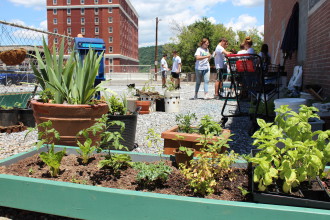Members of Elder & Sage: Uptown Asheville’s Senior Gardeners have long craved space to plant more flowers, herbs and vegetables. Lacking other options, the intrepid growers made do with tree pits, pavement cracks and small planters scattered around city-owned property at Haywood Street and Page Avenue for the past two years. But their hearts’ desire — a garden space at 33-35 Page Ave. (the former site of the Asheville Sister Cities building) — is finally coming to pass through the community gardens initiative of the Edible Asheville program.

On June 7, volunteers with Asheville Youth Missions, a service program that connects youth groups with service opportunities in the city, pitched in at the site to erect a portable shade structure, plant seeds and prepare soil for new planting boxes and containers. About 15 teens from Christ Episcopal Church in Ponte Vedra Beach, Fla., participated in the work. The previous day, said coordinator Naomi Rabago, the group had prepared a meal at the Haywood Street Congregation and worked to repair a retaining wall at the Veterans Restoration Quarters on Tunnel Road.
Battery Park resident Clare Hanrahan serves as the Page Avenue garden’s coordinator. She greeted passersby and pointed out the donations that were beginning to fill the site: hand-crafted planting boxes by Coleman Smith, soil delivered by the Warren Wilson College environmental and social justice crew and a pickle bucket from Burgerworx. Asheville City Council member Cecil Bothwell stopped by to check out the activity and promised Hanrahan he’d deliver a couple of potted tomato plants by the end of the week.
Bothwell said the logistics of providing water to the downtown lot had complicated efforts to get the garden growing, but said he believed the city had committed to installing a spigot. Until that’s in place, he said, the senior gardeners are “using a bucket brigade” to water the plants.



Kudos to the volunteers, and happy to see flower boxes and such going in. However, planting herbs & vegetables right in the middle of an area that already has a serious rat problem does not seem very smart. Many urban downtown areas require that any plantings in community gardens not be an obvious food source for rats. That’s also an area where dozens of people walk their dogs on a daily basis. Tomatoes? No thanks. Love the flowers though.
The raised beds solve the dog problem. Not clear about the rats.
Spoken like a true cat person (me too) – a critter with more refined hygiene. Unless it’s a Chihuahua or a Yorkie, the only thing a 6″ raised bed does is prompt yon poochie to raise the ol’ leg a little higher.
(Cross reference, John Boyle’s recent column on the fate of the very hearty hedges right across the street: “Answer Man: Dog Pee Killing Bushes?” http://www.citizen-times.com/story/news/local/2017/04/23/answer-man-dog-pee-killing-bushes-no-post-office-you/100704432/ ) But hey… it’s all “organic.”
As a council member, Mr. Bothwell may be in a position to help these community gardens manage any potential rat problems: https://www.bbg.org/gardening/article/managing_rats_in_city_gardens
Well, it’s been very difficult to get the county, city council and city bureaucracy to even acknowledge, much less take action against the existing rat problem which has been evident for a long time. (See articles linked below).
It took a series of articles and social media posts from local comedian Tom Scherve, and a report from WLOS, publicly shaming local authorities, to prompt any action at all. Not sure protecting a few tomato plants and a bunch of zucchinis will bring about a new vigilance.
This fenced raised bed garden lot is not and never has been an area where dozens of people walk their dogs on a daily basis.
Really not looking to tinkle on anyone’s parade. Like I said, love the flowers. And hope the new fence provides the needed protection for future plantings (it’s not all enclosed). Most of the current “crop” is outside the fence and right on the edge of the side walk. As for people not walking their dogs there – well, as a neighboring resident, my lyin’ eyes tell me otherwise. The broader point is that as both fodder for rodents, and because of its exposure to any number of potential contaminants, growing food there seems a really poor idea to me.
Mr. Change, your negative attitude is a contaminant. So you recommend that vegetables not be grown in cities? As long as the area is well maintained, free of garbage, compost piles, and harborage, a community garden that has fruits or vegetables growing is no more an attractant than what was there before. As a matter of fact, various herbs and other plantings help deter rats and vermin. The idea that any garden we put on city property will bring a swarm of rats stems from ignorance.
Contaminant? “Lordy” (as Jim Comey likes to say) lighten up already. While the concerns I posed are both real and well founded (no “fake news” here), they were framed in a fairly jocular way., and I have been nothing but complimentary of the general concept of an ornamental garden, and the good works of both the volunteers and the residents. The folks most involved in the gardens are my neighbors, and some are at least acquaintances. Over recent years I’ve delighted at the impromptu plantings of flowers. The whimsical arrangements of small figurines and toys, etc. Rarely does a day pass when I don’t observe and smile at their handiwork, and when I’ve seen them at work, I often thank them. I’m pleased they have additional space. But yes, I question the wisdom of this sudden shift to growing food there. There is already a very evident and well documented rat infestation in the area. The issue is not one of attracting them — they already inhabit this particular area in significant numbers.
http://www.citizen-times.com/story/news/local/2016/01/08/answer-man-downtown-rat-problem-being-ignored/78514962/
http://wlos.com/news/local/rat-problem-appears-to-grow-in-pritchard-park
And an even casual online search will provide plenty of evidence that many towns and cities have had to deal with urban community gardens being a food source for rodents.